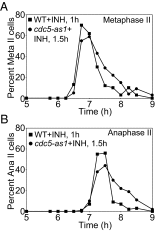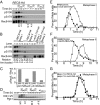Polo kinase Cdc5 is a central regulator of meiosis I
- PMID: 23918381
- PMCID: PMC3761645
- DOI: 10.1073/pnas.1311845110
Polo kinase Cdc5 is a central regulator of meiosis I
Abstract
During meiosis, two consecutive rounds of chromosome segregation yield four haploid gametes from one diploid cell. The Polo kinase Cdc5 is required for meiotic progression, but how Cdc5 coordinates multiple cell-cycle events during meiosis I is not understood. Here we show that CDC5-dependent phosphorylation of Rec8, a subunit of the cohesin complex that links sister chromatids, is required for efficient cohesin removal from chromosome arms, which is a prerequisite for meiosis I chromosome segregation. CDC5 also establishes conditions for centromeric cohesin removal during meiosis II by promoting the degradation of Spo13, a protein that protects centromeric cohesin during meiosis I. Despite CDC5's central role in meiosis I, the protein kinase is dispensable during meiosis II and does not even phosphorylate its meiosis I targets during the second meiotic division. We conclude that Cdc5 has evolved into a master regulator of the unique meiosis I chromosome segregation pattern.
Conflict of interest statement
The authors declare no conflict of interest.
Figures





References
-
- Archambault V, Glover DM. Polo-like kinases: Conservation and divergence in their functions and regulation. Nat Rev Mol Cell Biol. 2009;10(4):265–275. - PubMed
-
- Stegmeier F, Amon A. Closing mitosis: The functions of the Cdc14 phosphatase and its regulation. Annu Rev Genet. 2004;38:203–232. - PubMed
-
- Alexandru G, Uhlmann F, Mechtler K, Poupart MA, Nasmyth K. Phosphorylation of the cohesin subunit Scc1 by Polo/Cdc5 kinase regulates sister chromatid separation in yeast. Cell. 2001;105(4):459–472. - PubMed
-
- Marston AL, Amon A. Meiosis: Cell-cycle controls shuffle and deal. Nat Rev Mol Cell Biol. 2004;5(12):983–997. - PubMed
Publication types
MeSH terms
Substances
Grants and funding
LinkOut - more resources
Full Text Sources
Other Literature Sources
Molecular Biology Databases

